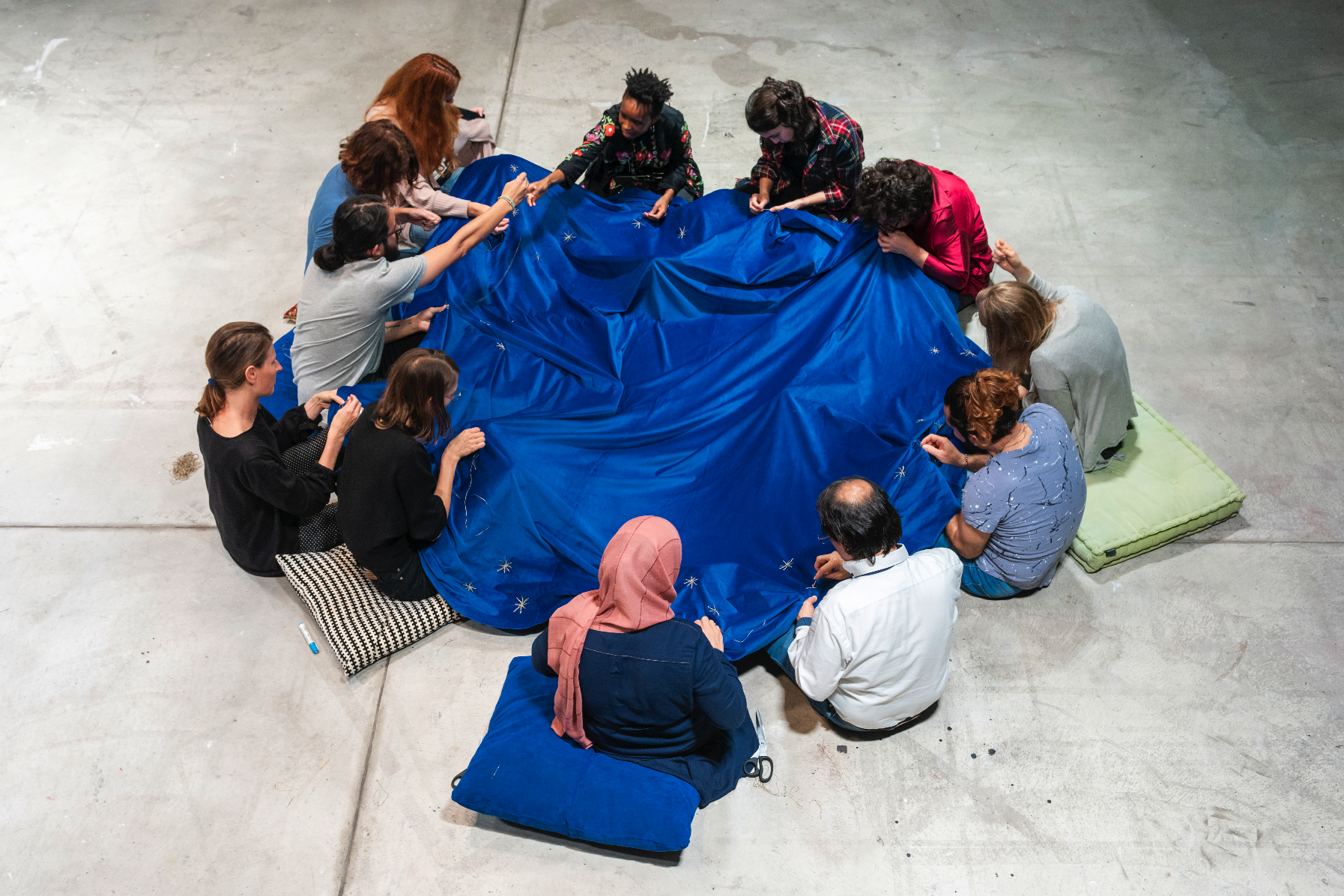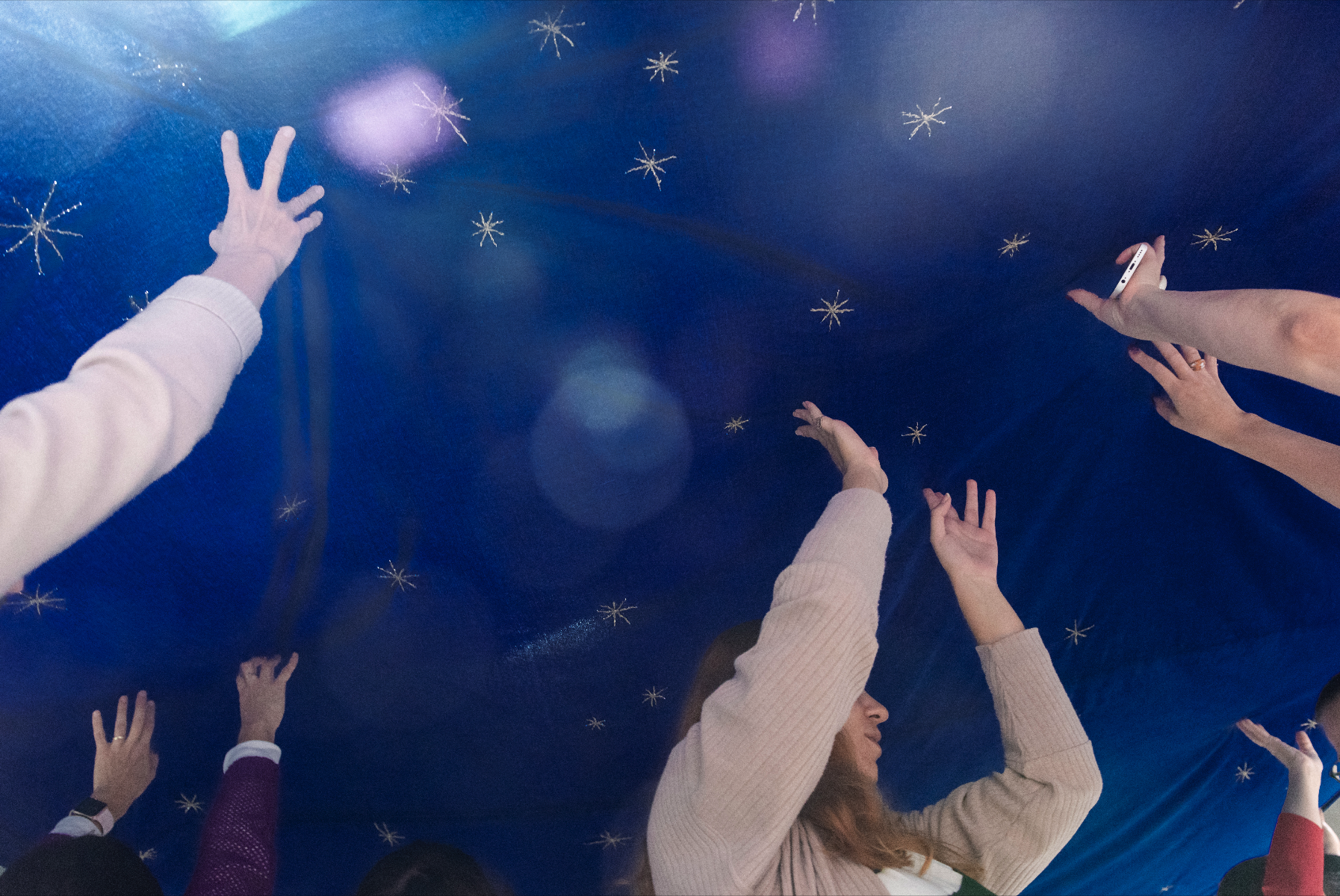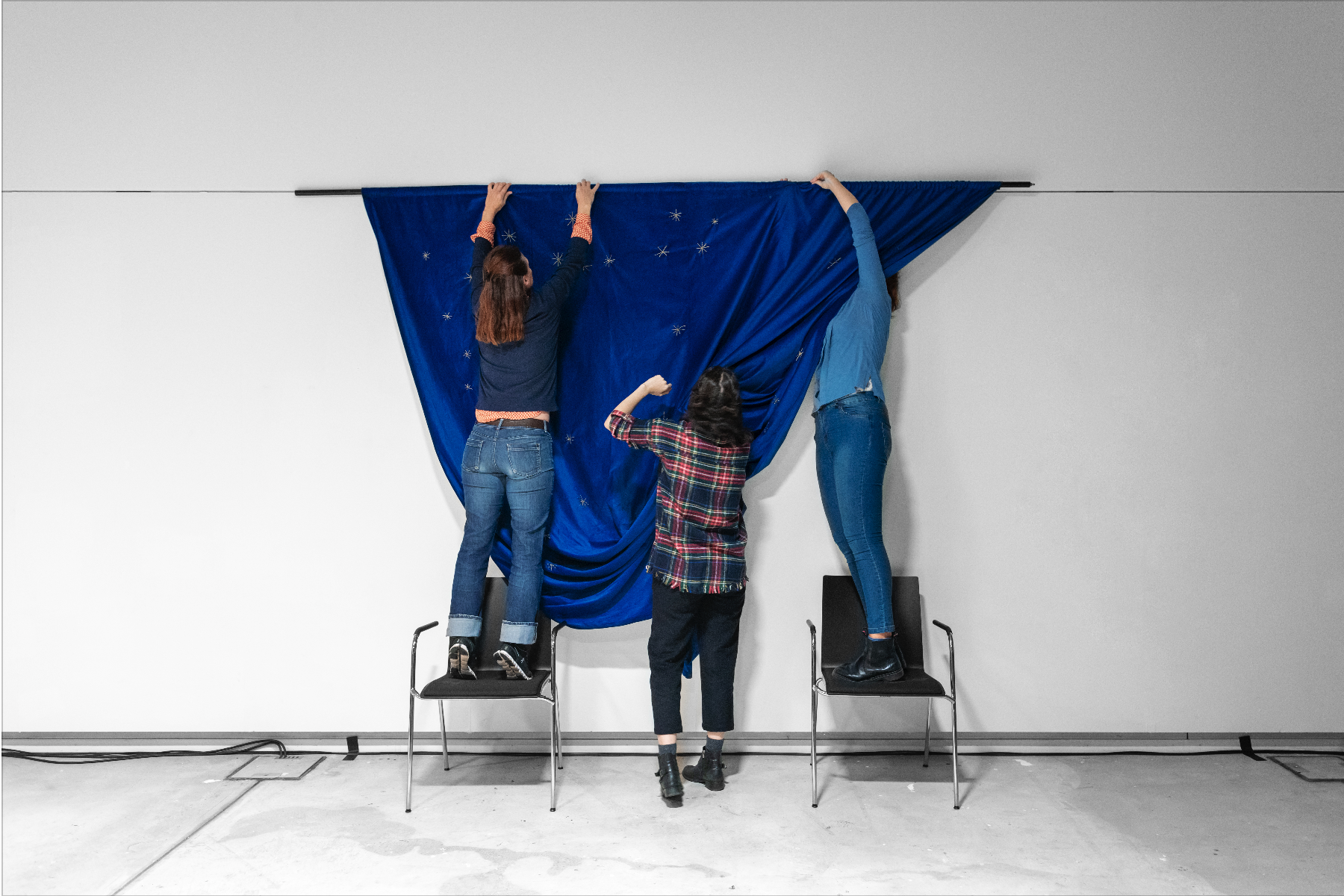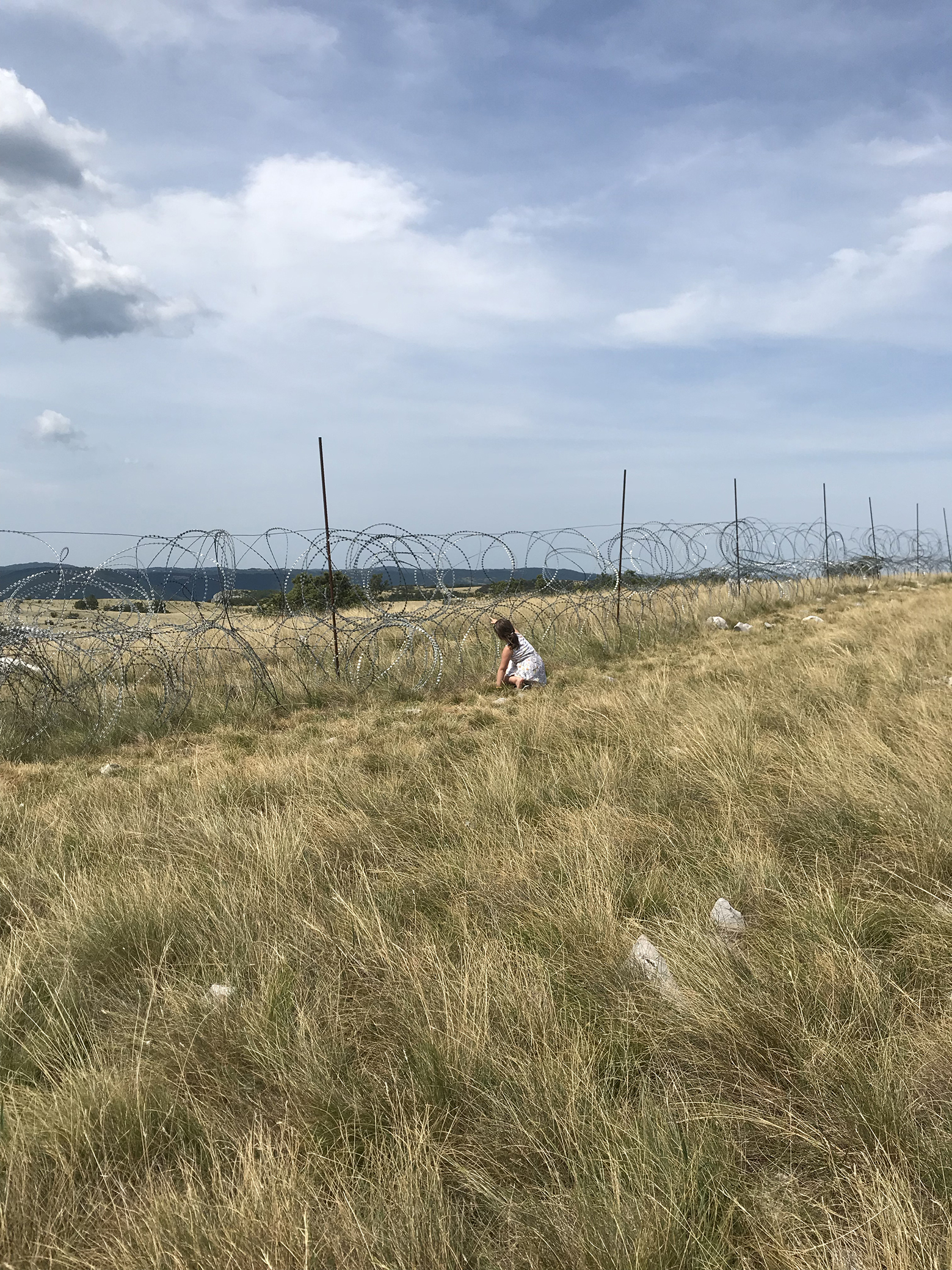Deutsche Version unten
19 October 2019, 18.30
Chi avrà più filo tesserà
Event #1 - Choreographing the Public
Artists: Filippo Berta, Maria Lai, Virginia Zanetti
Curated by: Francesca Ceccherini and Beatrice Fontana
This is first event of the series Choreographing the public, a multi-formatted and curatorial project focusing on the public
Images: Virginia Zanetti, performance Abissi, photo by Axel Crettenand; Filippo Berta, One by One, Italian Council 2019_ MIBACT, Nomas Foundation
PROGRAM:
Saturday 19 October, 15:00 – 18:30
PERFORMANCE | Abissi (Abysses) by Virginia Zanetti
Saturday 19 October, 18:30
VISIT AND ARTISTS TALK | with Filippo Berta and Virginia Zanetti
Video projection: Legarsi alla montagna (1981) by Maria Lai
At the KUNSTRAUM (5. K12), ZHdK Zürcher Hochschule der Künste, TONI-AREAL,
Zürich, Entrance Förrlibuckstrasse, 5th floor
A project of: IIC – Istituto Italiano di Cultura, Zurich for 15 Giornata del Contemporaneo IT.
In collaboration with: Migration Museum – Zurich (CH), Traffic Gallery – Bergamo (IT), Nomas Foundation – Rome (IT), Illisso Casa Editrice – Nuoro (IT), OnCurating Space – Zurich (CH).
Chi avrà più filo tesserà reflects on the subject of participation in art through the performative practices of three Italian artists of different generations: Virginia Zanetti (1981) and Filippo Berta (1977) together with Maria Lai (1919 – 2013), one of the most significant artistic personalities in the Italian recent past.
The event’s prime focuses are artistic practices that weave historical and social context with traditions and new rituals. In such circumstances, Virginia Zanetti will present her participative performance Abissi (Abysses). Filippo Berta, with the help of the images, will narrate to the public the story behind One by One, an art project which was selected as the winner of the last edition (2019) of the Italian Council Award (MIBAC – Ministero per i beni e le attività culturali). Both artists will discuss their works alongside with the screening of the video Legarsi alla Montagna (1981), which documents the homonymous performance staged by Maria Lai with the residents of Ulassai (Sardinia – IT).
The selected works share the common intent to generate acts which imply participation as means of self-definition. They entail public activation as a necessary condition for exploitation of new meanings and interpretations of the complexity of human relationships.
Virginia Zanetti’s performance, Abysses, will take place on October 19th from 15:00 to 19:00. This will involve residents and migrants living in Zurich, in the attempt to create a collective work by means of an embroidery practice on an ultramarine blue fabric.
This color symbolizes the sea, the ecosystem from which living beings originate, a trajectory often used by individuals to move from one place to another on our planet.
In the course of performative action, the artist invites participants to embroider a star with a precious golden thread. This star’s shape looks like those already painted by Giotto in the vault of the Scrovegni Chapel in Padua (IT) at the beginning of the 14th century.
Embroidery gives opportunity to share and collect memories related to the sea. This practice becomes a projection of desires and memories. It composes constellations made of today’s dreams.
At the end of the performance the fabric becomes the subject of a symbolic action: raised towards the sky, the blue abyss becomes sky itself. A sky full of new meanings in a delicate balance between space and time.
Filippo Berta’s ongoing project, One by One, will be discussed for the first time. The artist himself will narrate the impossible attempt to count all the thorns of the metal wire fences which still create geopolitical and cultural divisions as well as polarizations in different countries around the world: Slovenia, Croatia, Hungary, Serbia, Macedonia, Greece, Turkey, Korea, Mexico and United States. Recently built or still under construction, barbed wire walls stand as analogical presences within the society of digital control, revealing the conceptual contradictions of culturally fragile and socially divisive political choices.
In One by One, the artist involves the communities living close to such borders: each resident becomes a performer invited to count aloud, in his own language, each single thorn. The simple gesture of counting unmasks the social disharmonies induced by the logic of confinement, where ideological frontiers that prevent the natural human sociality exist.
The video document Legare Collegare by Tonino Casula, is the only video documentation testifying Maria Lai’s performance Legarsi alla Montagna (1981), a relational experiment dedicated to Ulassai, the artist’s birthplace in the mountains in Sardinia (IT).
Starting from the reinterpretation of an ancient, almost forgotten local legend – it narrates of a little girl found and rescued after a landslide in a cave where she took shelter during a thunderstorm while she tried to chase a light blue ribbon that appeared from nowhere – Maria Lai conceived a performative action reinterpreting the symbolic significance of the story. She involved women, men, children, young, and elderly people from Ulassai by provoking the action of tying houses, doors, balconies to one another. Each of them was asked to use for the purpose a different knot, according to their relationship: friendship, love, or conflict. A collective act based on the concept of union and transformation, in a region which already suffered from a progressive deurbanization.
This propitiatory ritual made everyone an interpreter of a new reality, designed to sew places to people and people to each other through infinite threads, by means of which the inseparable link between art and life was clearly expressed.
FILIPPO BERTA (1977)
The social strains generated by the relationship between individuals and the society to which they belong, constitute the subject of Filippo Berta’s artistic research. The boundaries marking this dialectical condition, quite often conflictual and problematic, are subject of analysis in his work. His attention to these social disharmonies translates into pieces which celebrate the daily gestures. The latter are so represented as to unmask their differences, tensions or contradictions. His work develops through collective performances, which are later synthetized in a single iconographic image and minimalistic videos.
Filippo Berta’s works have been exhibited or directly realized in different museums, biennials and cultural institutions all over the world. In 2019 his project, One by One, was selected among the winners of the Italian Council, an international call held by the MIBAC (Ministero per i Beni e le Attività Culturali).
VIRGINIA ZANETTI (1981)
The work of Virginia Zanetti attempts to identify and consequently break down the boundaries that divide the work of art from its fruitors. She obtains results by using simple and already acquired devices. She overcomes the conceptual gaps that lay at the most basic and archetypal level of knowledge, in the relational dynamics or within the codes shared by a community. Her works become an integral part of the environment in which they are conceived and produced; they function as collectors of human dynamics rather than simple objects of contemplation.
Virginia has several works exhibited or performed in Italian museums and abroad. In 2019 she won the photography award at Bologna Arte Fiera.
MARIA LAI (1919-2013)
Maria Lai was the only woman to attend the Sculpture Class at the Academy of Fine Arts from 1943 to 1945, under the guidance of Arturo Martini.
Considered one of the most influential Italian artist of the twentieth century, her work was marked by the unconventional use of techniques and materials stolen from everyday life and related to domestic and typical female work: bread and looms, embroidery and sewn books, ceramics and terracotta. Inspired by fairy tales and traditions of her native island, Sardinia, at the beginning of the 80s she turned her artistic research towards interventions that were directly connected with landscape. One of the most influential works remains the performance act Legarsi alla Montagna (1981). In a strongly symbolical act, all the houses of the small village of Ulassai were tied to the surrounding mountains with a blue ribbon over ten kilometres long.
The village of Ulassai hosts today a contemporary art museum La Stazione dell’Arte, which has collected over 100 works of Maria Lai, thanks to donors worldwide.
Dies ist Event #1 der Reihe Choreographing the public, ein kuratorisches Projekt, das sich auf die Öffentlichkeit konzentriert.
PROGRAMM:
Samstag 19. Oktober, um 15:00 – 18:30
PERFORMANCE | ‚Abissi‘ (Abgründe) von Virginia Zanetti
Samstag 19. Oktober, um 18:30
BESUCH UND KÜNSTLER*INGESPRÄCH | mit Filippo Berta und Virginia Zanetti
Videoprojektion: Legarsi alla montagna (1981) von Maria Lai
KUNSTRAUM (5. K12), ZHdK Zürcher Hochschule der Künste, TONI-AREAL,
Zürich, Entrance Förrlibuckstrasse, 5. Stockwerk
Ein Projekt von: IIC – Istituto Italiano di Cultura, Zürich für 15 Giornata del Contemporaneo IT.
In Zusammenarbeit mit: Migrationsmuseum – Zürich (CH), Traffic Gallery – Bergamo (IT), Nomas Foundation – Rom (IT), Illisso Casa Editrice – Nuoro (IT), OnCurating Space – Zürich (CH).
Chi avrà più filo tesserà reflektiert das Thema Kunstbeteiligung durch die performativen Praktiken von drei italienischen Künstler*innen verschiedener Generationen: Virginia Zanetti (1981) und Filippo Berta (1977) sowie Maria Lai (1919 – 2013), eine der bedeutendsten Künstlerpersönlichkeiten der jüngeren italienischen Vergangenheit.
Im Mittelpunkt der Veranstaltung stehen künstlerische Praktiken, die den historischen und sozialen Kontext mit Traditionen und neuen Ritualen verknüpfen. Unter diesen Umständen wird Virginia Zanetti ihre partizipative Performance Abissi (Abgründe) präsentieren. Filippo Berta wird mit Hilfe der Bilder der Öffentlichkeit die Geschichte von One by One erzählen, einem Kunstprojekt, das als Gewinner der letzten Ausgabe (2019) des Italian Council Award (MIBAC – Ministero per i beni e le attività culturali) ausgewählt wurde. Beide Künstler werden ihre Arbeiten im Rahmen der Vorführung des Videos Legarsi alla Montagna (1981) diskutieren, das die gleichnamige Performance von Maria Lai mit den Bewohnern von Ulassai (Sardinien – IT) dokumentiert.
Die ausgewählten Arbeiten teilen die gemeinsame Absicht, Akte zu generieren, die Partizipation als Mittel der Selbstdefinition implizieren. Sie beinhalten die öffentliche Aktivierung als notwendige Voraussetzung für die Nutzung neuer Bedeutungen und Interpretationen der Komplexität menschlicher Beziehungen.
Virginia Zanettis Performance Abysses findet am 19. Oktober von 15:00 bis 19:00 Uhr statt. Dabei werden in Zürich lebende Bewohner*innen und Migrant*innen einbezogen, um mit Hilfe einer Stickpraxis auf einem ultramarinblauen Stoff eine Gemeinschaftsarbeit zu schaffen.
Diese Farbe symbolisiert das Meer, das Ökosystem, aus dem die Lebewesen stammen, eine Trajektorie, die oft von Einzelpersonen benutzt wird, um von einem Ort zum anderen auf unserem Planeten zu gelangen.
Im Rahmen einer performativen Aktion lädt die Künstlerin die Teilnehmer*innen ein, einen Stern mit einem kostbaren Goldfaden zu besticken. Die Form dieses Sterns sieht aus wie die, die Giotto bereits zu Beginn des 14. Jahrhunderts im Gewölbe der Scrovegni-Kapelle in Padua (IT) gemalt hat.
Die Stickerei bietet die Möglichkeit, Erinnerungen an das Meer zu teilen und zu sammeln. Diese Praxis wird zu einer Projektion von Wünschen und Erinnerungen. Es komponiert Konstellationen aus den Träumen von heute.
Am Ende der Performance wird der Stoff zum Gegenstand einer symbolischen Aktion: Zum Himmel erhoben, wird der blaue Abgrund zum Himmel selbst. Ein Himmel voller neuer Bedeutungen in einem empfindlichen Gleichgewicht zwischen Raum und Zeit.
Das laufende Projekt von Filippo Berta, One by One, wird erstmals diskutiert. Die Künstlerin selbst wird den unmöglichen Versuch erzählen, alle Dornen der Metalldrahtzäune zu zählen, die noch immer geopolitische und kulturelle Spaltungen sowie Polarisierungen in verschiedenen Ländern der Welt erzeugen: Slowenien, Kroatien, Ungarn, Serbien, Mazedonien, Griechenland, Türkei, Korea, Mexiko und Vereinigte Staaten. Kürzlich errichtete oder noch im Bau befindliche Stacheldrahtwände stehen als analoge Präsenz in der Gesellschaft der digitalen Kontrolle und offenbaren die konzeptuellen Widersprüche kulturell fragiler und sozial gespaltener politischer Entscheidungen.
In One by One bezieht die Künstlerin die Gemeinschaften ein, die in der Nähe solcher Grenzen leben: Jede/r Bewohner*in wird zur/m Darsteller*in, die/der eingeladen wird, in ihrer/seiner eigenen Sprache jeden einzelnen Dorn laut zu zählen. Die einfache Geste des Zählens entlarvt die sozialen Disharmonien, die durch die Logik der Enge hervorgerufen werden, wo ideologische Grenzen existieren, die die natürliche menschliche Sozialität verhindern.
Das Videodokument Legare Collegare von Tonino Casula ist die einzige Videodokumentation, die Maria Lais Performance Legarsi alla Montagna (1981) bezeugt, ein relationales Experiment, das Ulassai gewidmet ist, dem Geburtsort des Künstlers in den Bergen Sardiniens (IT).
Ausgehend von der Neuinterpretation einer alten, fast vergessenen lokalen Legende – sie erzählt von einem kleinen Mädchen, das nach einem Erdrutsch in einer Höhle gefunden und gerettet wurde, wo sie während eines Gewitters Zuflucht fand, während sie versuchte, ein hellblaues Band zu verfolgen, das aus dem Nichts erschien – konzipierte Maria Lai eine performative Aktion, die die symbolische Bedeutung der Geschichte neu interpretierte. Sie beteiligte Frauen, Männer, Kinder, Jugendliche und ältere Menschen aus Ulassai, indem sie die Aktion provozierte, Häuser, Türen und Balkone aneinander zu binden. Jeder von ihnen wurde gebeten, für den Zweck einen anderen Knoten zu verwenden, je nach ihrer Beziehung: Freundschaft, Liebe oder Konflikt. Ein kollektiver Akt, der auf dem Konzept von Vereinigung und Transformation basiert, in einer Region, die bereits unter einer fortschreitenden Deurbanisierung litt.
Dieses Versöhnungsritual machte jeden zu einem Interpreten einer neuen Realität, die darauf abzielte, Menschen und Menschen durch unendliche Fäden miteinander zu verbinden, wodurch die untrennbare Verbindung zwischen Kunst und Leben deutlich wurde.
FILIPPO BERTA (1977)
Die sozialen Spannungen, die durch die Beziehung zwischen Individuen und der Gesellschaft, der sie angehören, entstehen, sind Gegenstand der künstlerischen Forschung von Filippo Berta. Die Grenzen, die diesen dialektischen Zustand kennzeichnen, oft konfliktträchtig und problematisch, sind Gegenstand der Analyse in seiner Arbeit. Seine Aufmerksamkeit für diese sozialen Disharmonien übersetzt sich in Stücke, die die täglichen Gesten feiern. Letztere sind so vertreten, dass sie ihre Unterschiede, Spannungen oder Widersprüche aufdecken. Seine Arbeit entwickelt sich durch kollektive Performances, die später zu einem einzigen ikonografischen Bild und minimalistischen Videos synthetisiert werden.
Filippo Berta’s Werke wurden in verschiedenen Museen, Biennalen und kulturellen Institutionen auf der ganzen Welt ausgestellt oder direkt realisiert. Im Jahr 2019 wurde sein Projekt One by One unter den Gewinnern des Italienischen Rates ausgewählt, einer internationalen Ausschreibung des MIBAC (Ministero per i Beni e le Attività Culturali).
VIRGINIA ZANETTI (1981)
Das Werk von Virginia Zanetti versucht, die Grenzen zu identifizieren und damit zu durchbrechen, die das Kunstwerk von seinen Früchten trennen. Sie erhält Ergebnisse durch den Einsatz einfacher und bereits erworbener Geräte. Sie überwindet die konzeptionellen Lücken, die auf dem grundlegendsten und archetypischsten Wissensstand, in der relationalen Dynamik oder innerhalb der von einer Gemeinschaft geteilten Codes liegen. Ihre Werke werden zu einem integralen Bestandteil der Umgebung, in der sie konzipiert und produziert werden; sie fungieren eher als Sammler der menschlichen Dynamik als als einfache Objekte der Kontemplation.
Virginia hat mehrere Werke ausgestellt oder in italienischen Museen und im Ausland aufgeführt. Im Jahr 2019 gewann sie den Fotopreis der Bologna Arte Fiera.
MARIA LAI (1919-2013)
Maria Lai war die einzige Frau, die von 1943 bis 1945 unter der Leitung von Arturo Martini den Skulpturenunterricht an der Akademie der Bildenden Künste besuchte.
Sie gilt als eine der einflussreichsten italienischen Künstlerinnen des 20. Jahrhunderts und zeichnet sich durch den unkonventionellen Einsatz von Techniken und Materialien aus, die aus dem Alltag genommen wurden und sich auf häusliche und typische Frauenarbeiten beziehen: Brot und Webstühle, Stickereien und genähte Bücher, Keramik und Terrakotta. Inspiriert von Märchen und Traditionen ihrer Heimatinsel Sardinien wandte sie sich Anfang der 80er Jahre künstlerischen Forschungen zu Interventionen zu, die direkt mit der Landschaft verbunden waren. Eines der einflussreichsten Werke bleibt der Performance-Akt Legarsi alla Montagna (1981). In einem stark symbolischen Akt wurden alle Häuser des kleinen Dorfes Ulassai mit einem blauen Band über zehn Kilometer lang an die umliegenden Berge gebunden.
Das Dorf Ulassai beherbergt heute ein Museum für zeitgenössische Kunst La Stazione dell’Arte, das dank internationaler Spender über 100 Werke von Maria Lai gesammelt hat.



